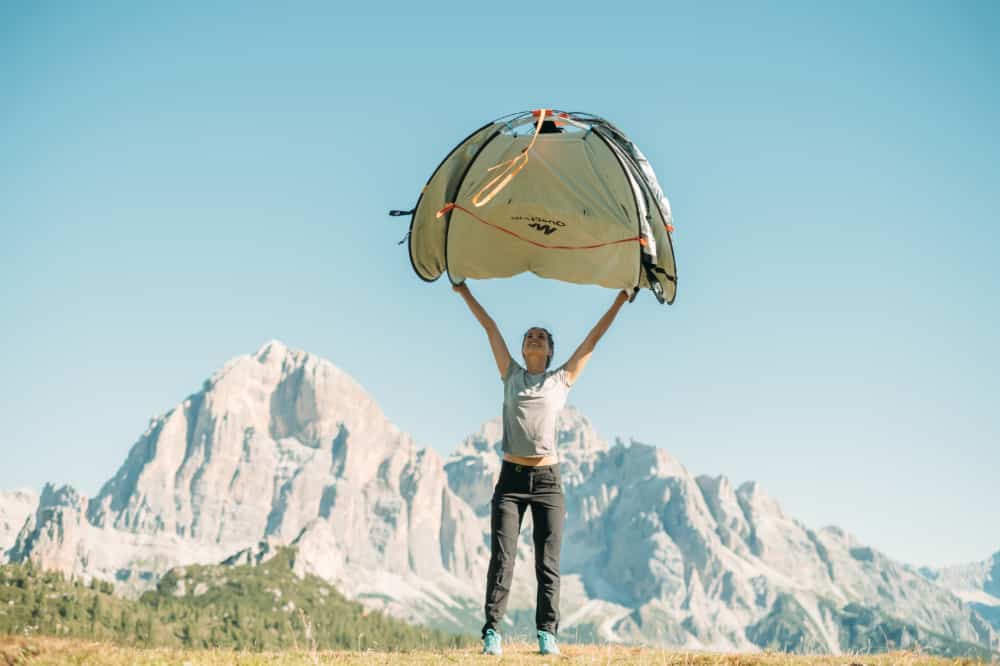Do you love the idea of camping but hate having to faff around with setting up a tent? A pop up tent may be for you.
Simply throw the tent on the ground and it explodes into a fully formed tent.
But before you buy a pop up tent, make sure you fully understand their drawbacks. A mistake here can lead to a rainy disaster of a night.
So what is a pop up tent exactly? Read on!

What is a pop up tent?
A pop up tent is a fast setup tent that ‘pops’ itself into shape. You simply have to open the tent bag, remove the tent and throw it into the air. The tent then grows into a full tent shape.
A pop up type tent is considered the easiest tent to set up. These are followed closely by instant tents which instead have pre-attached telescopic poles that can be extended (like a telescope) to pitch the tent.
As a result, pop-up tents are an excellent choice of tent for beginners.
However, their ease of use and all round beginner friendliness comes at a cost. They are not as lightweight as backpacking tents, they are not suited to bad weather conditions and they are typically not as durable.
If you’re a fan of keeping muddy boots in the porch then you’re out of luck. The pop up nature of these tents means that they don’t come with extras like a vestibule or porch.
How do pop up tents work?
Pop up tents have spring loaded tent poles which come pre-attached to the body of the tent. The tent bag keeps these springs compressed and the tent folded, but when you take it out of the bag the springs force the tent poles to extend. The rapidly extending tent poles push all the walls of the tent into the right places and the tent pops up in front of you, full formed.
This is very different to a conventional tent where you have a bag of tent poles that you need to feed through fabric loops until the frame is constructed.
While setting up a pop up tent just requires taking it out of the bag, throwing it on the floor and pegging it down, folding it away is a little more difficult.
How to fold a pop up tent
Pop up tents must be folded in a specific way when you’re wanting to put down the tent. This can depend on the tent manufacturer to make sure to check the instructions that come with the tent.
To fold a pop up tent:
- Ensure the door of the pop up tent is open so that the air can escape.
- Fold together the two top tent poles and keep a hold of them.
- Grab the two bottom poles and bring them towards the top poles. These tent poles should all fold together into a tortilla shape.
- Keeping your hand in place, grab the remaining bottom poles of the tent tortilla and fold it into where your hand is holding. This leaves you with a shape representing two circles.
- Slide the two circles together to make a single tent circle.
- Place back into the pop up tent bag.
When Might I Need a Pop Up Tent?
Pop up tents are great for:
- Family friendly camping – especially as a first tent for kids
- Casual camping for those who just want to chuck the tent down and chill out
- People with mobility challenges
- People looking for a easy budget tent
- Anyone going to a festival
Are pop up tents durable?
Pop up tents are not very durable. They often use cheaper materials like fiberglass tent poles and polyester tent walls, but this isn’t necessarily an issue. The main issue is around the durability of the tent poles and the ability to repair the tent.
In particular, the tent poles are prone to breaking in heavy winds. And since they’re preattached spring poles, you can’t replace them when they do break.
This means that a damaged pop up tent typically requires replacing the whole tent. However, there are a few tent brands that can replace the tent poles so do make sure to check with the manufacturer before getting rid of the tent.
Pop up tents in the rain and wind
Are pop up tents waterproof?
Pop up tents are waterproof in fair weather. However, they aren’t designed to hold up to harsh weather – particularly if there are strong winds and heavy rain.
Some pop up tents do perform better than others however. Generally a waterproof tent has:
- An attachable rainfly
- A high hydrostatic head rating (a key waterproof rating) – if this isn’t published, you can usually assume it’s made for fair weather only
- Sealed seams
If the forecast is for a bit of rain and you’re worried about the waterproofing, do make sure to pick up some waterproofing spray (we like the Kiwi spray) and give the tent a good coverage.
A rain fly is also needed for keeping out heavier rain.

Pop up tents in the wind
Pop up tents can bend considerably in heavy winds which lead to the poles snapping. This is partially due to the spring style construction of the tent poles and also the cheaper materials used in construction.
Do make sure to properly stake down the tent and be careful to check the weather forecast ahead of camping.
How do pop-up tents cope with condensation?
As a rule of thumb, if the pop up tent doesn’t come with a rainfly, it will probably have condensation problems.
Condensation can be combatted with plenty of ventilation. Often tents have mesh walls and windows and then you can place a rainfly over the top which ensures the tent is both well ventilation and protected from rain.
Do make sure to check the ventilation of the tent before buying. Waking up in a pool of water can be particularly miserable.
How do pop up tents relate to instant tents?
Pop up tents are a type of instant tent. That is, all pop up tents are instant tents, but not all instant tents are pop up tents.
In general, pop up tents are faster to set up than conventional instant tents, although they’re a little more tricky to put away. For more info on instant tents, check out our article what is an instant tent?
